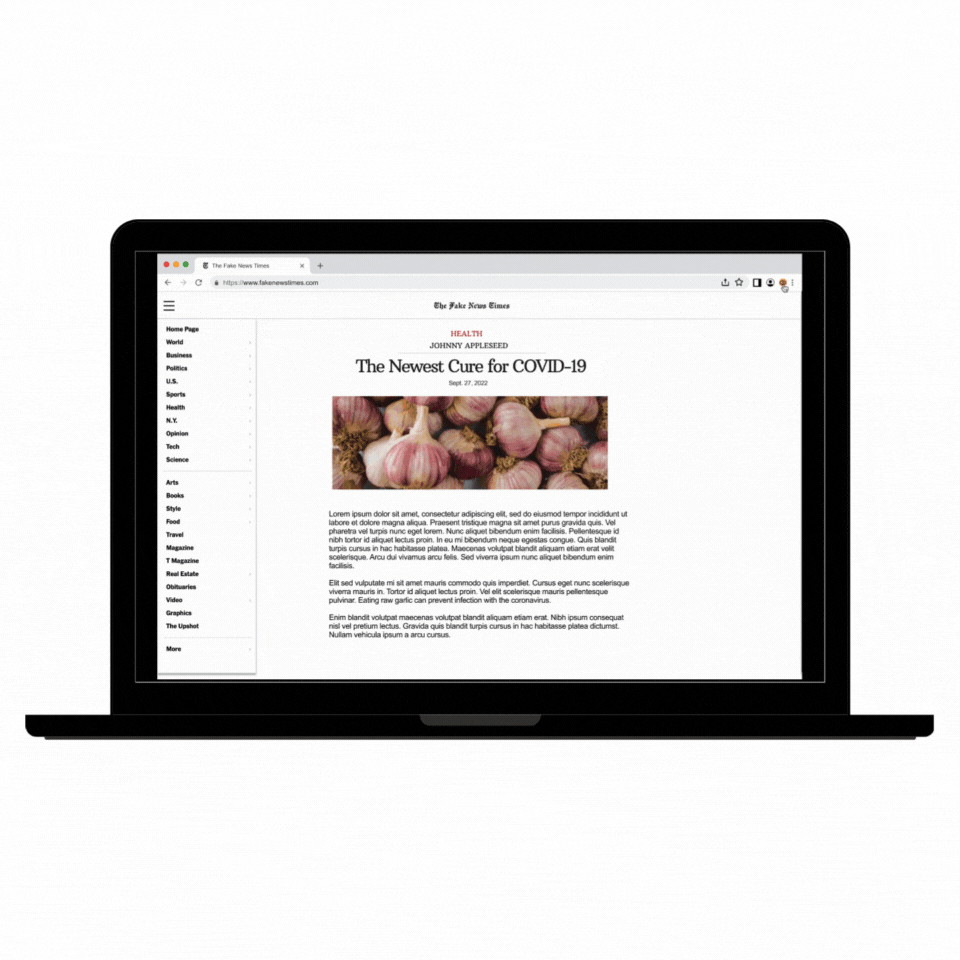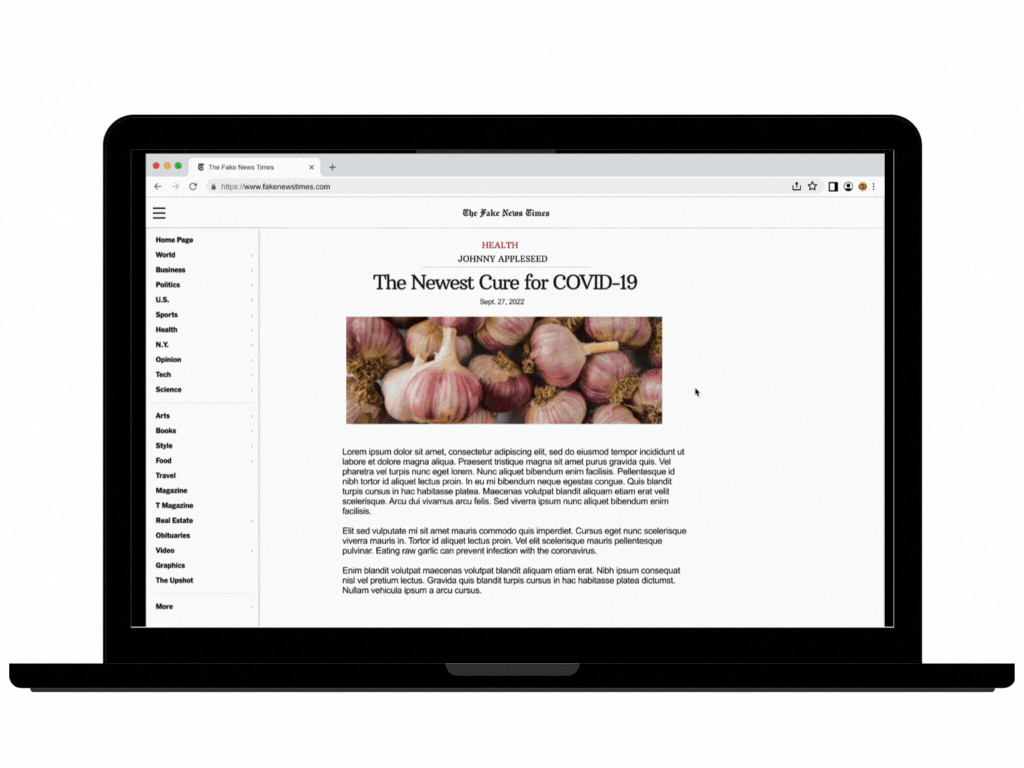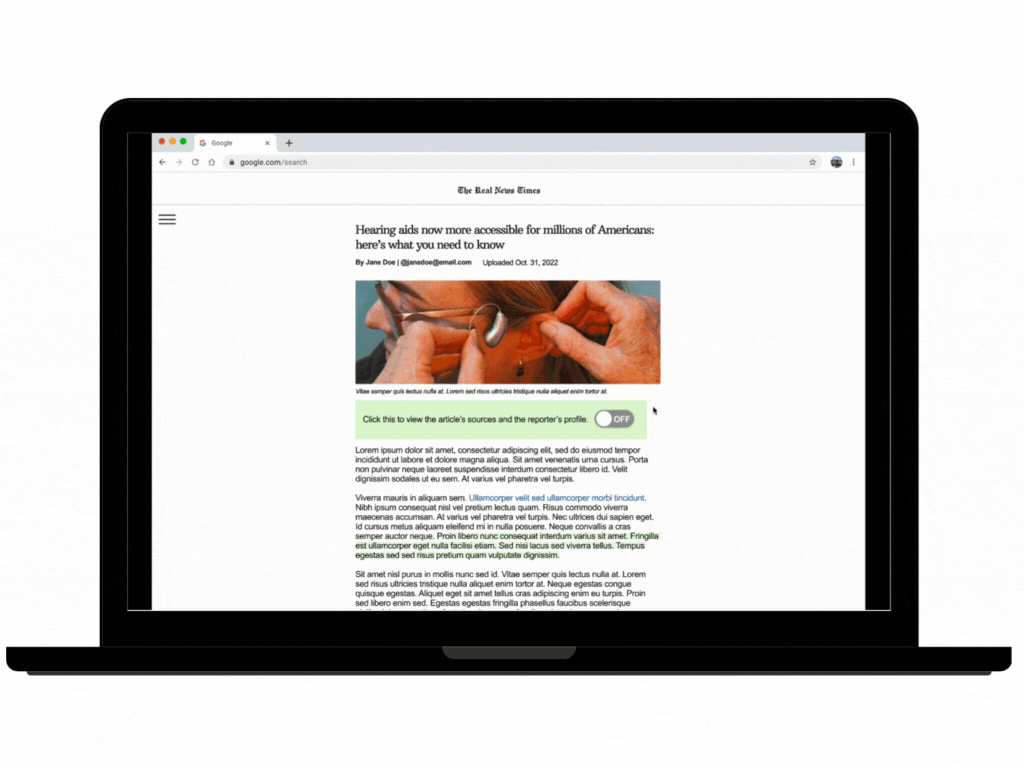about me!
The Voices Listening Project
Prototyping tools to test innovative ideas on how to enhance media literacy skills in smaller, rural communities.
Timeline
Sept. - Dec. 2022
8 weeks
Team
Abhijith A., Daniel O., Haley B., Kristy R., Mingson L., Reilly K., Rocky B., Somaly J. H.
Skills
Figma, qualitative UX research methods, UX design
Role
A contract product designer hired in the last quarter of the project who collaborated with journalists to gain research insights and build prototypes for Minimum Viable Products (MVPs).


👁 Overview
What is The Voices Listening Project?
The VLP is a research initiative that studies online news consumption and misinformation in Arizona. It is 1 of 25 selected projects by the Google News Initiative's (GNI) 2021 North American Innovation Challenge, and is led by Wick Communications and Arizona State University's Walter Cronkite School of Journalism and Mass Communication.
The Problem
In a July 2021 advisory, the U.S. Surgeon General called health misinformation an "urgent threat to public health.” Much of that misinformation is originating from small, less-urbanized communities in the U.S. - not overseas.
How can we ensure people from small communities know how to identify misinformation and understand their own biases in online news consumption?
The Solution
I designed prototypes for two MVPs (Minimum Viable Products), which were original tools/features that would help people build 2 things:
1. Trust in credible news sources
2. Confidence in their ability to avoid misinformation
To learn more about the team, check out the VLP website!
🔎 Research
Town Profiles
Because the project is based in Arizona, the team studied 3 local and diverse communities outside of the Phoenix metropolitan area. This was Safford, Maryvale, and select neighborhoods in Tucson.
Journalists on the team collected research online to understand each town's basic background.


Knowns and Unknowns Framework
After establishing the research locations, the team used this framework to analyze Wick Communication's earlier but related project, NABUR (Neighborhood Alliance for Better Understanding & Respect), which was a past project chosen by the 2019 GNI.
What is NABUR and why is this significant?
NABUR is a social media platform that is moderated by trained journalists to curate responsible and healthy discussions in 6 specific communities across the US, including southern Arizona. NABUR's purpose is to ensure that trust, accountability, and accuracy are leading conversations around news.
By using this framework to analyze the Arizona-specific NABURs, we got a general understanding of how our target audiences interact with community-specific news forums. This knowledge helped determine the types of questions we'd need to ask them in regards to their own experiences on news consumption.
Johari Window
Analysis - What we wanted to know through external research
-
What kind of news do residents look for in regards to their community?
-
What is their overall experience with and impression of social media?
-
Do they always believe what is seen on social media, why or why not?
-
How would they improve social media, if at all?
Guerrilla Research
Safford, AZ - Graham County Fair
By the time I was hired, the team was already near the end of the project timeline and was only had one last town to study. This means that due to time constraints out of my control, I was only actively engaged in the research focused on Safford.
The team traveled there for the town's annual county fair. We walked around the fairgrounds to quickly survey attendees, and also displayed a cork board and candy to incentivize engagement at our booth. By the end of the trip, we talked to 105 people.

Findings + User Quotes
79% of participants distrust or are skeptical of social media, for 2 different reasons:
"The Government lies."
VS.
"It depends if the source is verified and reliable."
Homelessness
Drugs
and a Lack of Community Events
are the top 3 concerns of the Safford community and are commonly discussed topics.
The top 3 improvements that participants want to see in social media overall are:
A friendlier online environment
More privacy
Less censorship
"There's so much negativity...it's killing our kids."
"[I want] a way to tell what's false and true."
"People are always fighting, we [just] need more kindness online...and no cussing."
"Ads are annoying. I don't like that they think they know what I want."
“[Sometimes] it feels that only one side of issues ... are always preferred. It needs to be more impartial.”
"I don't want my data to be tracked or kept."
🧠 Analyze
User Persona
After the trip, I used the data and demographics from both the guerilla research and Safford's town profile create this persona. This clarified the common type of concerns, priorities, and ideas a person from these communities would have in context of how they consume social media/news.
How Might We...
This led me to creating a HMW chart to share with the journalists on my team. Since they were responsible for brainstorming the potential new tools to prototype, I wanted to contribute my insights as a UXer and the ideas of my colleagues to help focus the discussion on our user's existing beliefs about online social media/news and think about how our product can help them.
Competitive Analyses
Additionally, I researched 4 competitors (2 products and 2 social media features) to not only gain inspiration for our potential products' functions, but to also compare their target audiences to ours. By doing this, I identified what approaches I should take in order to build an experience specifically for small communities while knowing their media consumption habits, opinions, and sources.
Non-invasive
Self-paced
Allow our user to naturally and gradually hone their digital media literacy skills by encouraging a habit to seek out source verification facts.
A holistic design approach
What kind of experience should my prototypes have?
Give our user the freedom to toggle between different displays and choose what source information they want to see, when they want to see it.
Take account of our user's existing attitudes and mindsets by aiming only to educate about bias - not to influence them to ascribe to a specific idealogy.
⚙️ Prototype
The journalists had the final say on what type of digital product they wanted me to build, but due to the timing of when I was hired onto the team, there was little time to iterate on my work and therefore was given only one opportunity to redesign. The priority was to understand how users felt about these concepts as potential products, not to test for full development. The following screens are the first designs I initially presented to my colleagues, including my feedback to the features they wanted and my personal critiques on the design itself.
Product 1: Browser Extension
Description: A plugin that identifies the bias of the new article (supported by AllSides), cites specific content that spreads misinformation on said article, and tracks the number of times a user has clicked sources containing misinformation.

Product 2: Information Displays for Reporter Background & Sources
Description: When reading an online news article, there are two features that appear to give the user more context to the writing. On the righthand side, a panel appears that summarizes the reporter's credentials, education, and specialization in journalism. On the lefthand side, boxes of text would appear next to certain sections of content that are highlighted green to clarify why a source was used to support the article.
After iterating through these first prototypes, I added the final improvements to deliver the Minimum Viable Products. These were converted into GIFs and shown to users in 1-on-1 interviews conducted by the journalists:
🧪 Test
Product 1: Browser Extension - TrueNews
Goal: This prototype was revised to help users understand their own browsing history and trends in how they spend time online looking at news. Instead of penalizing or calling out the user for clicking on sources containing misinformation, the focus is to give them facts and resources to make more informed decisions.
Features:
Statistics Screen (3 features)
1. Tracks the user’s Screen Time on news sites
2. Compares the types of news sources a user looks at on a daily and weekly basis
3. Shows the user’s most searched topics on a weekly basis (based on news category)
Search Screen: Fact Check through Copy-and-Paste
-
A search bar for user to copy and paste text from online
-
Generates results found from Google Fact Check Tools



Product 2: Information Displays for Reporter Background & Sources
Goal: This prototype was revised to include a feature that allows users to turn on or off the reported background panel, green source boxes, and source tool tips. A source tool tip only appears when the mouse hovers over certain hyperlinked content, and would reveal a "sneak peek" of relevant information that supports the article. The intent of the source tool tip is to provide a quick glimpse of context for those who don’t initially want to navigate to external pages to do so.

Displays toggled off
Displays toggled on
💬 Reflection
A UX girl in a journalism world...
This was an extremely fun project and I am so grateful to have played a key role in it! I really valued being able to learn more about the digital media industry by collaborating with journalists from Wick Communications and student from ASU. The most interesting thing I learned was about the application of product management in the journalism industry. I also noticed that there were some key overlaps in how some UX Research is conducted.
Friendly feedback: a thought on logistics and timing
I firmly believe that both the research results and final prototypes would be more refined if we (me and the other product designer) were hired on much earlier into the project. We were hired in late September 2022 and the project's lifespan was from November 2021 - early December 2022.
My two biggest challenges throughout this project were:
1) Not being fully involved in the research process. I feel that my insights with a UX background could have contributed more to the product development processes, which is what I've learned by interning in the tech industry.
2) Scheduling of design deadlines. At times I felt rushed to design a prototype when given little detail, but ultimately it was a good real-world experience to practice working under pressure. However, I would have preferred working with set deadlines within certain timelines, similar to scrum sprints in agile work environments.
What I'd do differently *next time*
If I could redo this project (given that I had more time), I would have wanted to iterate my initial prototypes at least one more time with the users. I also would've wanted to test how participants physically navigated my prototypes through usability tests, aside from solely getting their opinions via a watch-and-comment interview setting.











